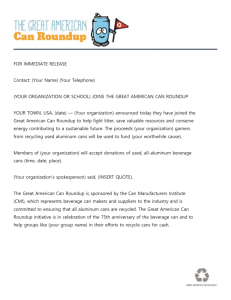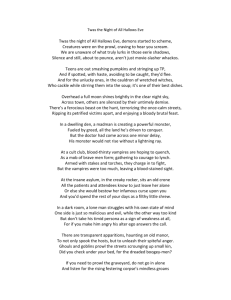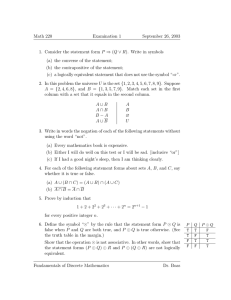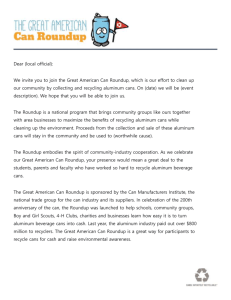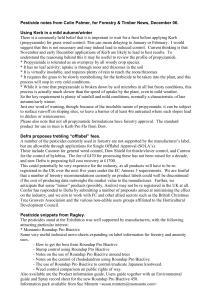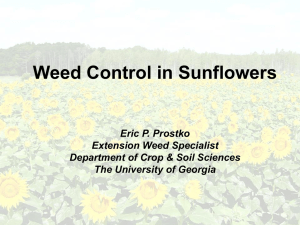Weed Control in Arizona Ultra Narrow Row Cotton: 1999 Preliminary Results
advertisement
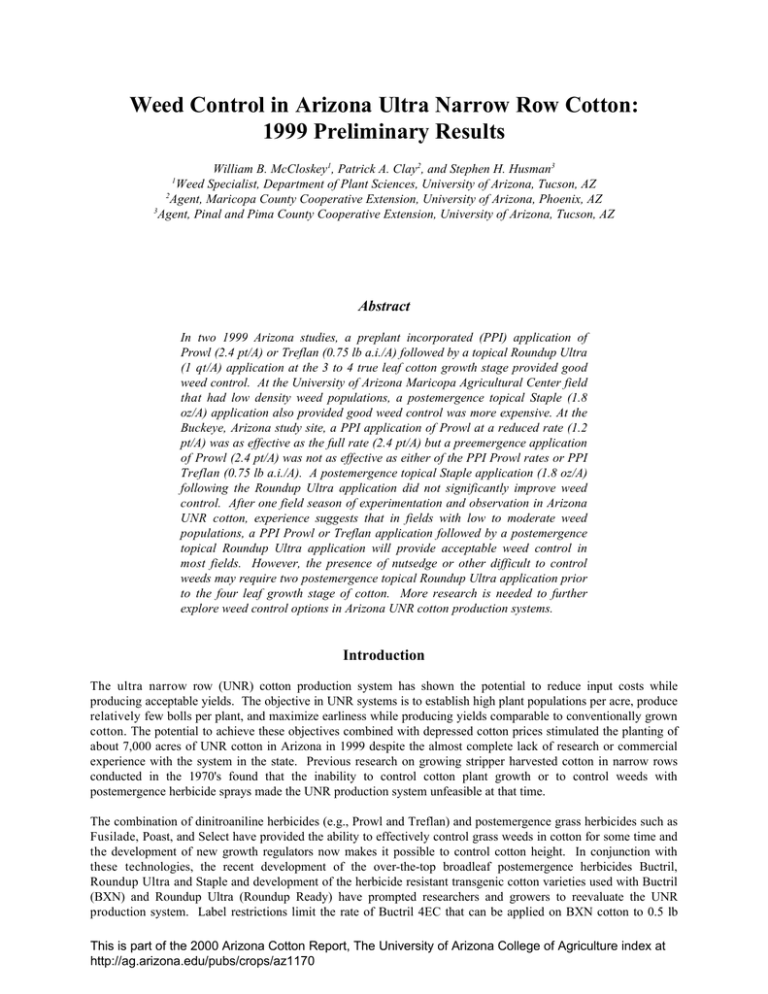
Weed Control in Arizona Ultra Narrow Row Cotton: 1999 Preliminary Results William B. McCloskey1, Patrick A. Clay2, and Stephen H. Husman3 Weed Specialist, Department of Plant Sciences, University of Arizona, Tucson, AZ 2 Agent, Maricopa County Cooperative Extension, University of Arizona, Phoenix, AZ 3 Agent, Pinal and Pima County Cooperative Extension, University of Arizona, Tucson, AZ 1 Abstract In two 1999 Arizona studies, a preplant incorporated (PPI) application of Prowl (2.4 pt/A) or Treflan (0.75 lb a.i./A) followed by a topical Roundup Ultra (1 qt/A) application at the 3 to 4 true leaf cotton growth stage provided good weed control. At the University of Arizona Maricopa Agricultural Center field that had low density weed populations, a postemergence topical Staple (1.8 oz/A) application also provided good weed control was more expensive. At the Buckeye, Arizona study site, a PPI application of Prowl at a reduced rate (1.2 pt/A) was as effective as the full rate (2.4 pt/A) but a preemergence application of Prowl (2.4 pt/A) was not as effective as either of the PPI Prowl rates or PPI Treflan (0.75 lb a.i./A). A postemergence topical Staple application (1.8 oz/A) following the Roundup Ultra application did not significantly improve weed control. After one field season of experimentation and observation in Arizona UNR cotton, experience suggests that in fields with low to moderate weed populations, a PPI Prowl or Treflan application followed by a postemergence topical Roundup Ultra application will provide acceptable weed control in most fields. However, the presence of nutsedge or other difficult to control weeds may require two postemergence topical Roundup Ultra application prior to the four leaf growth stage of cotton. More research is needed to further explore weed control options in Arizona UNR cotton production systems. Introduction The ultra narrow row (UNR) cotton production system has shown the potential to reduce input costs while producing acceptable yields. The objective in UNR systems is to establish high plant populations per acre, produce relatively few bolls per plant, and maximize earliness while producing yields comparable to conventionally grown cotton. The potential to achieve these objectives combined with depressed cotton prices stimulated the planting of about 7,000 acres of UNR cotton in Arizona in 1999 despite the almost complete lack of research or commercial experience with the system in the state. Previous research on growing stripper harvested cotton in narrow rows conducted in the 1970's found that the inability to control cotton plant growth or to control weeds with postemergence herbicide sprays made the UNR production system unfeasible at that time. The combination of dinitroaniline herbicides (e.g., Prowl and Treflan) and postemergence grass herbicides such as Fusilade, Poast, and Select have provided the ability to effectively control grass weeds in cotton for some time and the development of new growth regulators now makes it possible to control cotton height. In conjunction with these technologies, the recent development of the over-the-top broadleaf postemergence herbicides Buctril, Roundup Ultra and Staple and development of the herbicide resistant transgenic cotton varieties used with Buctril (BXN) and Roundup Ultra (Roundup Ready) have prompted researchers and growers to reevaluate the UNR production system. Label restrictions limit the rate of Buctril 4EC that can be applied on BXN cotton to 0.5 lb This is part of the 2000 Arizona Cotton Report, The University of Arizona College of Agriculture index at http://ag.arizona.edu/pubs/crops/az1170 a.i./sprayed A (1 pt/sprayed A) which is not enough to control most broadleaf weed seedlings in Arizona. Thus, the objectives of the two experiments reported here were to evaluate the use of preemergence herbicides (i.e., Prowl and Treflan), and the postemergence herbicides Roundup Ultra in conjunction with Roundup Ready (RR) cotton, and Staple for weed control in UNR cotton grown in Arizona. Materials and Methods Two experiments were conducted in 1999; one at the University of Arizona Maricopa Agricultural Center (MAC) and one on a commercial farm in Buckeye, AZ. The experiment at MAC was conducted in a field with a loam soil and used a complete block, split-plot design with four blocks. The main plot factor was row spacing, either 10 or 40 inch, and the subplot factor was cotton variety, either Sure Grow 747 (SG 747) or Delta Pine 429RR (DP 429RR). Since the subplots were 20 feet wide by 800 feet, each main plot was 40 feet wide by 800 feet which was the length of the field. The varieties were chosen based on their potential to mature early and on the use of different over-the-top weed control programs, either Staple (pyrithiobac) on SG 747 or Roundup Ultra (glyphosate) on DP 429RR. The conventional or 40 inch row spacing subplots at MAC were treated prior to bed formation with Prowl 3.3 (pendimethalin) at a rate of 2.4 pints/A (1 lb a.i./A). The herbicide was applied in 23 gallons of water per acre (GPA) at 30 psi using flat-fan TeeJet XR8004VK nozzles. The boom containing the nozzles was mounted on a field cultivator equipped with three ranks of s-tines operated at 6.1 mph to incorporate the herbicide immediately after spraying. The conventional plots were then listed, mulched, and beds were shaped in preparation for planting. Within the UNR main plots, the SG747-Staple subplots were treated with Prowl at 2.4 pt/A. However, in the DP 429RR-Roundup Ultra subplots, two rates of Prowl were compared to an untreated area 50 feet long by 20 feet wide in order to evaluate the feasibility of using a Roundup Ultra only postemergence weed control program. An area 75 by 20 feet was treated with Prowl at 1.8 pt/A (0.74 lb a.i./A) and the remaining subplot area (approximately 675 feet by 20 feet wide) was treated with Prowl at 2.4 pt/A. The Prowl was applied using XR8003VS nozzles in 13.5 GPA at 20.5 psi with a tractor-mounted sprayer equipped with a 20 foot boom traveling at 4.3 mph. The herbicide was incorporated about 30 min after application using a field cultivator equipped with three ranks of s-tines operated at 6.1 mph. The UNR plots were dry planted on the flat in borders at a seeding rate of 33 pounds per acre using a set of 10 John Deere 71 unit planters arranged on a double tool bar to plant rows 10 inches apart. The conventional plots were dry planted using a seeding rate of 12 pounds per acre with a single seed line per bed using a John Deere 6300 Max Emerge planter. Irrigation was initiated on April 29 to germinate the seed. The conventional plots received surface applied furrow irrigation water in every other furrow. The UNR plots were sprinkler irrigated using a solid set, hand moved, system in order to eliminate soil crusting and insure a high rate of seedling emergence and good stand uniformity. The sprinkler irrigation was a non-conventional practice and was cost prohibitive on a commercial basis but was implemented to avoid non-uniform, low density stands for experimental purposes. The remaining in-season UNR main plot irrigations were surface applied. Cotton plant populations on June 2 were 44,000 and 115,000 plants/A in the conventional and UNR plots, respectively. The UNR DP 429RR subplots were treated with Roundup Ultra at 1 qt/A plus spray grade ammonium sulfate (AMS) at 8.5 lb/100 gallons of water and the UNR SG 747 subplots were treated with Staple at 1.8 oz/A plus 0.5% (v/v) non-ionic surfactant (X-77) on May 27 when the cotton was at the 3 to 4 true leaf growth stage. The herbicides were applied at a speed of 3.2 mph in 24 GPA at 35 psi using 11 XR8003VS nozzles and one OC-06 nozzle (on the end of the boom) on a tractor mounted boom that extended about 20 feet beyond the side of the tractor. Since weed populations in the experiment were low, no additional herbicides were applied in the UNR plots. Cultivation of the conventional plots during the season controlled the few weeds that escaped the preplant incorporated (PPI) Prowl application and no additional herbicide was applied. The other agronomic and IPM practices used in the MAC experiment are reported elsewhere in this Cotton Report (Husman et.al., 2000). The UNR herbicide experiment in Buckeye, AZ was conducted in a commercial field with a sandy loam soil and included several different preemergence herbicide treatments, either Treflan (trifluralin) or various rates of Prowl followed by postemergence applications of either Roundup Ultra alone or Roundup Ultra followed by Staple. The experimental plots were 20 feet wide by 65 feet long and were arranged in a randomized complete block design with four blocks. The PPI herbicide treatments were applied on March 29, 1999 in 16.8 GPA with XR8004VS nozzles at 20 psi using a tractor-mounted sprayer equipped with a 20 foot boom traveling at 4.3 mph. The herbicide treatments were incorporated within about 4 hr of application using a field cultivator. Short wide beds were formed prior to dry planting with DP 5690RR on April 15 using a 7, 13, 7, 13... inch planting pattern resulting in an average row spacing of 10 inches. There were four drill lines per bed with a 13 inch space between the center two rows on the beds and a 13 inch space with a shallow furrow (approximately 3 inches deep and about 4 inches wide) in between beds. The preemergence Prowl treatment was applied after planting on April 17 using a CO2 backpack sprayer with application parameters similar to those used for the PPI applications. The field was irrigated on April 19 to germinate the cotton seed resulting in a 48 hr delay between application and incorporation. Daytime highs were in the upper 80's F during this period. The entire experimental area was sprayed with Roundup Ultra at 1 qt/A (0.75 lb a.e./A) by air in 5 GPA on May 20. Selected plots were sprayed with Staple at 1.8 oz/A plus X-77 at 0.5% (v/v) on May 25. A preemergence weed control evaluation was made on May 19 and a postemergence weed control evaluation was done on June 3. Thirteen feet of four drill rows (i.e., one bed) in each plot was hand harvested on October 12. The number of plants in one drill row were also counted to determine plant populations in each plot and the number of bolls per plant on eight plants per plot were counted when the experiment was harvested. The entire field was also plant mapped by mapping 5 representative plants in each quadrant of the field (i.e., NE, SE, SW and NW sections). A seed cotton sample from each plot was ginned separately in a small gin at MAC to determine gin turnout and sub-samples were sent to the USDA Cotton Classing Office in Phoenix, Arizona for grade and High Volume Instrument (HVI) classing. Results and Discussion Weed populations at the Maricopa Ag. Center (MAC) study site were very small and problem species such as annual morningglory (Ipomoea spp.) and Palmer amaranth (Amaranthus palmeri) and perennials such as purple (Cyperus rotundus) and yellow nutsedge (Cyperus esculentus) and bermudagrass (Cynodon dactylon) were not present. The weeds that emerged in the DP 429RR UNR subplots that were not treated with PPI herbicide consisted almost entirely of common purslane (Portulaca oleracea). Both the 2.4 pt/A and 1.8 pt/A rates of Prowl applied PPI resulted in 95 to 98% control of common purslane in both the UNR and conventional row spacing main-plots. The application of Roundup Ultra at 1 qt/A plus AMS resulted in only about 50 to 60% control of common purslane. Although the purslane plants did not die immediately, they turned chlorotic and were severely stunted such that herbicide injury combined with the rapid canopy development of the UNR cotton suppressed the purslane for the remainder of the season. The postemergence application of Roundup Ultra or Staple to the DP 429RR or SG 747 subplots, respectively, effectively controlled (>98%) the few weeds that escaped the PPI Prowl applications. Thus, the Prowl followed by Roundup Ultra and the Prowl followed by Staple herbicide programs were equally effective in a field with low weed populations although the Staple application was about twice as expensive as the Roundup Ultra application. The UNR experiment in Buckeye was conducted in a commercial field with a sandy loam soil and moderate to high weed populations. The PPI and preemergence herbicide treatments significantly reduced the number of winter-spring and summer annual weeds that emerged (Tables 1 and 2). Similar trends were evident with respect to the control of both winter and summer annual weeds. At labeled rates, Treflan and Prowl provided equivalent control of all weed species when applied and mechanically incorporated prior to planting. No stunting of the cotton was observed in the PPI and preemergence herbicide treated plots relative to the untreated plots. Reducing the PPI rate of Prowl from 1 lb a.i./A (2.4 pt/A) to 0.5 lb a.i./A (1.2 pt/A) slightly reduced control of little mallow, Palmer amaranth, and puncture vine but the differences were not statistically significant (Tables 1 and 2). The preemergence Prowl application at 1.0 lb a.i./A resulted in poorer control of all weed species compared to the PPI applications of Prowl at both the 1.0 and 0.5 lb a.i./A rates or Treflan at 0.75 lb a.i./A (Tables 1 and 2). For nettleleaf goosefoot, little mallow, Palmer amaranth, common purslane and puncture vine, the loss of control was substantial. The loss of weed control in the preemergence Prowl treatment was due mainly to the less efficient incorporation achieved with irrigation compared to mechanical incorporation. The loss of control may also have been due partly to the 48 hr delay after application before the herbicide was incorporated by irrigation. During this period, the weather was sunny and warm with daytime highs in the upper 80’s (F). Thus, some Prowl was probably lost due to photodegradation and volatilization prior to incorporation. On May 20, the entire experiment was sprayed with Roundup Ultra at 0.75 lb a.e./A (1 qt/A) by air when the cotton was at the 3 true leaf growth stage. Weed control was evaluated 14 days later on June 3. Since only the control of emerged weeds was evaluated, the ratings do not reflect differences in weed population densities due to the various preplant and preemergence herbicide treatments. Only little mallow, Palmer amaranth and common purslane were present in sufficient densities to allow evaluation. Despite the fact that Palmer amaranth plants were between 6 to 10 inches tall when Roundup Ultra was applied, excellent control was obtained (Table 3). In contrast, little mallow and common purslane control was marginal (Table 3) but the weeds were stunted and chlorotic. This injury in combination with high cotton plant densities, rapid canopy closure and shading suppressed these species for the remainder of the season except where there were gaps in the cotton canopy. The sequential application of Staple after the Roundup Ultra application did not significantly improve postemergence weed control although it did cause some stunting of the cotton (Table 3). Data collected at the end of the season included stand counts, number of bolls per plant and hand harvested yields. A whole field plant mapping survey found that the cotton plants averaged 21.8 ± 1.1 nodes (mean ± std. dev.) and were 35.0 ± 3.3 inches tall. There were no significant differences between treatments with respect to plant populations (Table 4) although there was substantial variation in the data due to non-uniform moisture conditions and the small area counted and harvested. Since all of the treatments in Table 4 received the same postemergence Roundup Ultra application, the data indicate that the method or rate of Prowl application did not affect cotton populations and that there was no difference between Treflan and Prowl in this regard. The number of bolls per plant varied between 3.7 and 4.5 with no significant differences between treatments. Similarly, there were no significant differences in seed cotton and lint yields between treatments (Table 4). The average turnout of 35.7% was unusually high for UNR cotton because it was hand harvested. In addition, fiber quality parameters did not reflect the differences in weed populations between treatments that existed in the plots at harvest due to the fact that the cotton was not machine harvested with a stripper picker. Of the 28 plot samples submitted to the classing office, 10 contained extraneous matter in the form of cracked seed (31), possibly due to premature termination of the crop. Micronaire, staple length, and fiber strength were not significantly affected by the herbicide treatments and were within acceptable ranges (Table 5). Summary In two 1999 Arizona studies, a preplant incorporated (PPI) application of Prowl (2.4 pt/A) or Treflan (0.75 lb a.i./A) followed by topical Roundup Ultra (1 qt/A) at the 3 to 4 true leaf cotton growth stage provided good weed control. At the University of Arizona Maricopa Agricultural Center site that had low density weed populations, a postemergence topical Staple (1.8 oz/A) application also provided good weed control but was about twice as expensive as the Roundup Ultra application. At the Buckeye, Arizona study site, a PPI application of Prowl at a reduced rate (1.2 pt/A) was as effective as the full rate (2.4 pt/A) but a preemergence application of Prowl (2.4 pt/A) was not as effective as either of the PPI Prowl rates or PPI Treflan at 0.75 lb a.i./A. A sequential postemergence topical Staple application (1.8 oz/A) following the Roundup Ultra application did not significantly improve weed control. After one field season of experimentation and observation in Arizona UNR cotton, experience suggests that in fields with low to moderate weed populations, a PPI Prowl or Treflan application followed by a postemergence topical Roundup Ultra application will provide acceptable weed control in most fields. However, the presence of nutsedge or other difficult to control weeds may require two postemergence topical Roundup Ultra application prior to the four leaf growth stage of cotton. More research is needed to further explore weed control options in Arizona UNR cotton production systems. References Husman, S. H., W.B. McCloskey, T. Teegerstrom and P.A. Clay. 2000. Agronomic and economic evaluation of ultra narrow row cotton production in Arizona in 1999. Cotton, A College of Agriculture Report, Series P-121, University of Arizona, Tucson, AZ. In press. Table 1. Effect of various preemergence herbicide treatments on the emergence of winter weeds in UNR cotton in Buckeye, AZ. Percent weed control on May 19, 1999 Rate1 CHEAL2 CHEMU2 MALPA2 SSYIR2 ( /A) (%) (%) (%) (%) Untreated fb Roundup -0.75 0 c3 0c 0c 0b Prowl PPI4 fb Roundup 0.5 0.75 98 a 97 a 92 a 99 a Prowl PPI fb Roundup 1.0 0.75 98 a 98 a 98 a 98 a Prowl PRE4 fb Roundup 1.0 0.75 94 b 50 b 81 b 98 a Prowl PPI fb Roundup fb Staple 1.0 0.75 1.5 99 a 99 a 99 a 99 a Treatment Treflan PPI 0.75 98 a 98 a 98 a 98 a fb Roundup 0.75 1 Prowl and Treflan: lb a.i./A; Staple: oz a.i./A; Roundup Ultra: lb a.e./A. 2 CHEAL = Chenopodium album, common lambsquarter; CHEMU = Chenopodium murale, nettleleaf goosefoot; MALPA = Malva parviflora, little mallow; SSYIR = Sisymbrium irio, London rocket. 3 Data are means of four values; means within a column followed by the same letter are not significantly different (P=0.05) according to Tukey’s HSD. 4 PPI = preplant incorporated on the flat; PRE = applied preemergence to the soil surface after bed formation and planting about 48 hr prior to irrigation. Table 2. Effect of various preemergence herbicide treatments on the emergence of summer weeds in UNR cotton in Buckeye, AZ. Percent weed control on May 19, 1999 Rate1 AMAPA2 AMABL2 POROL2 TRBTE2 (/A) (%) (%) (%) (%) Untreated fb Roundup -0.75 0 c3 0c 0c 0b Prowl PPI4 fb Roundup 0.5 0.75 94 a 97 a 96 a 94 a Prowl PPI fb Roundup 1.0 0.75 98 a 98 a 99 a 98 a Prowl PRE4 fb Roundup 1.0 0.75 61 b 94 b 72 b 57 b Prowl PPI fb Roundup fb Staple 1.0 0.75 1.5 98 a 99 a 99 a 99 a Treatment Treflan PPI 0.75 98 a 98 a 98 a 98 a fb Roundup 0.75 1 Prowl and Treflan: lb a.i./A; Staple: oz a.i./A; Roundup Ultra: lb a.e./A. 2 AMAPA = Amaranthus Palmeri, Palmer amaranth; AMABL = Amaranthus blitoides, prostrate pigweed; POROL = Portulaca oleracea, common purselane; TRBTE = Tribulus terrestris, puncture vine. 3 Data are means of four values; means within a column followed by the same letter are not significantly different (P=0.05) according to Tukey’s HSD. 4 PPI = preplant incorporated on the flat; PRE = applied preemergence to the soil surface after bed formation and planting about 48 hr prior to irrigation. Table 3. Effect of various postemergence herbicide treatments on the control of weeds in UNR cotton in Buckeye, AZ. The evaluation considered only the control of emerged vegetation and not differences in population densities due to the various preemergence herbicide applications. Weed control and injury on June 3, 1999 Rate1 MALPA2 AMAPA2 POROL2 Cotton injury (/A) (%) (%) (%) (%) Untreated fb Roundup -0.75 45 a3 99 a 48 a 0b Prowl PPI4 fb Roundup 0.5 0.75 44 a 98 a –5 0b Prowl PPI fb Roundup 1.0 0.75 45 a 99 a 45 a 0b Prowl PRE4 fb Roundup 1.0 0.75 45 a 99 a 45 a 0b Prowl PPI fb Roundup fb Staple 1.0 0.75 1.5 50 a 99 a 53 a 15 a Treatment Treflan PPI 0.75 41 a 98 a 42 a 0b fb Roundup 0.75 2 Prowl and Treflan: lb a.i./A; Staple: oz a.i./A; Roundup Ultra: lb a.e./A. 1 AMAPA = Amaranthus Palmeri, Palmer amaranth; POROL = Portulaca oleracea, common purselane; TRBTE = Tribulus terrestris, puncture vine. 3 Data are means of four values; means within a column followed by the same letter are not significantly different (P=0.05) according to Tukey’s HSD. 4 PPI = preplant incorporated on the flat; PRE = applied preemergence to the soil surface after bed formation and planting about 48 hr prior to irrigation. 5 Insufficient population to evaluate. Table 4. Plant populations, number of bolls per plant, and yield of hand harvested DP 5690RR UNR cotton in Buckeye, AZ. Data collected at harvest on Oct. 12, 1999 Rate1 Cotton popln. Bolls Seed cotton lint yield (/A) (#/A) (#/plant) (lb/A) (lb/A) Untreated fb Roundup -0.75 129,675 a2 3.8 a 2821 a 1004 a Prowl PPI3 fb Roundup 0.5 0.75 134,701 a 4.5 a 2960 a 1055 a Prowl PPI fb Roundup 1.0 0.75 141,738 a 3.7 a 2937 a 1038 a Prowl PRE3 fb Roundup 1.0 0.75 151,790 a 4.2 a 2971 a 1065 a Prowl PPI fb Roundup fb Staple 1.0 0.75 1.5 -- -- -- -- Treatment Treflan PPI 0.75 133,696 a 4.3 a 3260 a 1157 a fb Roundup 0.75 1 Prowl and Treflan: lb a.i./A; Staple: oz a.i./A; Roundup Ultra: lb a.e./A. 2 Data are means of four values except for the bolls/plant data which are means of four plots with 8 sub-samples per plot; means within a column followed by the same letter are not significantly different (P=0.05) according to Tukey’s HSD. 3 PPI = preplant incorporated on the flat; PRE = applied preemergence to the soil surface after bed formation and planting about 48 hr prior to irrigation. Table 5. Cotton lint quality parameters of hand harvested DP 5690RR UNR cotton in Buckeye, AZ. Cotton harvested on Oct. 12, 1999 Treatment Rate1 Micronaire (/A) Staple length Fiber Strength (inch) (g/tex) Untreated fb Roundup -0.75 4.18 a2 1.15 a 32.9 a Prowl PPI3 fb Roundup 0.5 0.75 4.28 a 1.07 ab 31.5 ab Prowl PPI fb Roundup 1.0 0.75 4.25 a 1.06 b 30.2 b Prowl PRE3 fb Roundup 1.0 0.75 3.97 a 1.07 ab 30.7 ab Treflan PPI 0.75 4.55 a 1.10 ab 31.6 a fb Roundup 0.75 1 Prowl and Treflan: lb a.i./A; Staple: oz a.i./A; Roundup Ultra: lb a.e./A. 2 Data are means of four values; means within a column followed by the same letter are not significantly different (P=0.05) according to Tukey’s HSD. 3 PPI = preplant incorporated on the flat; PRE = applied preemergence to the soil surface after bed formation and planting about 48 hr prior to irrigation.
